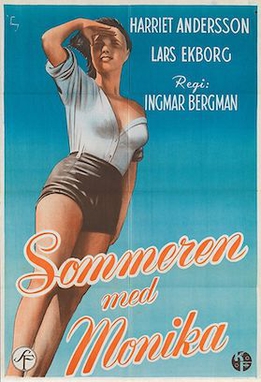Summer with Monika
1953 film From Wikipedia, the free encyclopedia
Summer with Monika (Swedish: Sommaren med Monika) is a 1953 Swedish romance film. The motion picture was both written and directed by Ingmar Bergman. This featured Harriet Andersson and Lars Ekborg portraying the main characters. The plot was derived from one of Per Anders Fogelström's novels, of which had the same title, from 1951. Controversial because of one scene portrayal of au naturel and, along with the film One Summer of Happiness from the year before, directed by Arne Mattsson, contributed to an idea of Sweden as an immodest, sexually loose population.
| Sommaren med Monika | |
|---|---|
 Original Swedish film poster | |
| Directed by | Ingmar Bergman |
| Written by | Ingmar Bergman |
| Based on | Sommaren med Monika 1951 novel by Per Anders Fogelström |
| Produced by | Allan Ekelund |
| Starring | Harriet Andersson Lars Ekborg |
| Cinematography | Gunnar Fischer |
| Music by | Erik Nordgren Les Baxter |
Release dates |
|
Running time | 96 minutes |
| Country | Sweden |
| Language | Swedish |
The film made a star of its lead actress, Andersson. Bergman had been intimately involved with Andersson at the time and conceived the film as a vehicle for her. The two of them would continue to work together, even after their romantic relationship had ended, in films like Sawdust and Tinsel, Smiles of a Summer Night, Through a Glass Darkly, and Cries and Whispers.
Plot
Summarize
Perspective
In Stockholm, the young working-class Harry meets Monika, an adventurous young woman, in a cafe near to his workplace. Monika invites Harry to join her to see a movie at the local cinema after his work shift. The two spend the rest of the evening together, and find themselves enamored of one another. At her home, Monika tires of her alcoholic father's incessant drinking and violent outbursts, packs her belongings and runs away. She seeks help from Harry, who goes to spend the night with her in his father's docked boat. After getting into an argument with his boss the following morning, Harry quits his job.
The two decide to leave the city, and take the boat into the Stockholm Archipelago, where they spend an idyllic summer together. When the end of the summer forces them to return home, it is clear that Monika is pregnant. Harry happily accepts responsibility and settles down with Monika and their child; he gets a real job and goes to night school to provide for his family. Monika, however, is unsatisfied with her role as homemaker. She yearns for excitement and adventure, a desire which finally leads her astray. Harry leaves town for work and comes home a day early to find his wife with another man. After deciding to separate and in his rage at her flippancy, Harry hits her and leaves the apartment. They get a divorce and Monika flees the responsibility of child rearing leaving Harry with custody of their daughter, June, to raise alone. In the final shot while he looks in a mirror, he fantasizes about the time they spent together.
Cast
- Harriet Andersson as Monika
- Lars Ekborg as Harry
- John Harryson as Lelle
- Georg Skarstedt as Harry's father
- Dagmar Ebbesen as Harry's aunt
- Åke Fridell as Monika's father
- Naemi Briese as Monika's mother
- Åke Grönberg as Harry's friend at work
- Sigge Fürst as Porcelain warehouse worker
US release
Summarize
Perspective
In 1955, two years after the film was released in Sweden, a high-profile article "Sin & Sweden" was written in Time magazine, about living conditions in a secularized Swedish society. The debate in the US that followed, in the midst of the Cold War, was marked by conservative hostility to anything resembling socialism. This and above all commercial interests contributed to the exploitation market's interest in the concept of Swedish sin.[1][2]

Also in 1955, exploitation film presenter Kroger Babb purchased the US rights to the film. To increase excitement for the film, he edited it down to 62 minutes and emphasized the film's nudity. Renaming the film Monika, the Story of a Bad Girl, he provided a good deal of suggestive promotional material, including postcards featuring the nude Andersson.[3]
The exploitation version of Bergman’s film successfully played rural drive-in theatres for years, unaffected by the fact that a year later it was re-contracted, this time with Janus Films, to let the uncut, subtitled version play at art-theaters as well. The film was thus available to two different types of American audiences simultaneously.[4]
Reception
Summer with Monika has a 100% approval rating on Rotten Tomatoes.[5]
See also
- Nudity in film
- The exploitation film Blonde in Bondage (1957) is directly inspired by the Time magazine article.[4]
References
External links
Wikiwand - on
Seamless Wikipedia browsing. On steroids.
